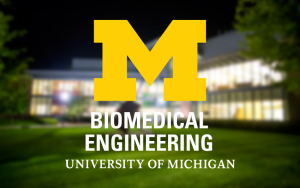Presented By: Biomedical Engineering
Evaluation of Phosphate Treatment and Long-Term RUNX2 Suppression On Adult Human MSC Chondrogenesis and Neo-Cartilage Formation
BME Ph.D. Defense: Tiana Wong

Abstract:
Clinical repair strategies for articular cartilage defects are limited by the inability of the tissue to self-repair, often resulting in post-traumatic osteoarthritis (PTOA). PTOA arises from the degradation of structural cartilage extracellular matrix (ECM) proteins responsible for maintaining articular cartilage mechanics, such as aggrecan and collagen. Current cartilage tissue engineering strategies aim to utilize human-derived cells to regenerate cartilage prior to the onset of PTOA. Limited availability of chondrocytes – the primary cell type in articular cartilage – imposes a need for alternatives. Human mesenchymal stem cells (hMSCs) are a promising solution as they can be found in a variety of tissues and can differentiate into MSC-derived chondrocytes (MdChs). However, MSCs are limited by their inability to produce a stable chondrogenic phenotype and deposit and maintain ECM in long-term culture due to maturation, (hypertrophy) where metalloproteinases cleave collagen II and aggrecan. As a result, MSC-derived cartilage regeneration techniques are not yet suitable for clinical use. The central objective of this thesis is to increase cartilage matrix accumulation for more clinically functional cartilage tissue by increasing matrix deposition and stabilizing the chondrogenic phenotype of MSCs.
We investigated two approaches to increase cartilage ECM accumulation and improve MdCh-based cartilage tissue engineering functional outcomes: inorganic phosphate (Pi) treatment and RUNX2 suppression. First, we found that Pi increased cartilage ECM production, but also increased MdCh hypertrophy, while RUNX2 suppression increased stiffness of neo-cartilage tissues long-term. Finally, we showed that combined treatment of Pi and RUNX2 suppression exhibited reduced MdCh hypertrophy but did not significantly increase matrix accumulation. Overall, this dissertation explores methodologies that promote both cartilage matrix accumulation and reduces cartilage matrix loss during long-term culture to better support the use of MdChs in cartilage defect repair strategies.
Zoom Link: https://umich.zoom.us/j/98189564171 Password: cartilage
Committee Chair: Dr. Rhima Coleman
Clinical repair strategies for articular cartilage defects are limited by the inability of the tissue to self-repair, often resulting in post-traumatic osteoarthritis (PTOA). PTOA arises from the degradation of structural cartilage extracellular matrix (ECM) proteins responsible for maintaining articular cartilage mechanics, such as aggrecan and collagen. Current cartilage tissue engineering strategies aim to utilize human-derived cells to regenerate cartilage prior to the onset of PTOA. Limited availability of chondrocytes – the primary cell type in articular cartilage – imposes a need for alternatives. Human mesenchymal stem cells (hMSCs) are a promising solution as they can be found in a variety of tissues and can differentiate into MSC-derived chondrocytes (MdChs). However, MSCs are limited by their inability to produce a stable chondrogenic phenotype and deposit and maintain ECM in long-term culture due to maturation, (hypertrophy) where metalloproteinases cleave collagen II and aggrecan. As a result, MSC-derived cartilage regeneration techniques are not yet suitable for clinical use. The central objective of this thesis is to increase cartilage matrix accumulation for more clinically functional cartilage tissue by increasing matrix deposition and stabilizing the chondrogenic phenotype of MSCs.
We investigated two approaches to increase cartilage ECM accumulation and improve MdCh-based cartilage tissue engineering functional outcomes: inorganic phosphate (Pi) treatment and RUNX2 suppression. First, we found that Pi increased cartilage ECM production, but also increased MdCh hypertrophy, while RUNX2 suppression increased stiffness of neo-cartilage tissues long-term. Finally, we showed that combined treatment of Pi and RUNX2 suppression exhibited reduced MdCh hypertrophy but did not significantly increase matrix accumulation. Overall, this dissertation explores methodologies that promote both cartilage matrix accumulation and reduces cartilage matrix loss during long-term culture to better support the use of MdChs in cartilage defect repair strategies.
Zoom Link: https://umich.zoom.us/j/98189564171 Password: cartilage
Committee Chair: Dr. Rhima Coleman